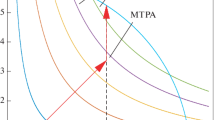Abstract
A comparative analysis of the dynamic characteristics of field-oriented induction motor drive control systems relying on the main magnetic flux linkage vector reference, space-vector pulse width modulation (SVPWM) of the voltage inverter output, and direct torque control (DTC) is carried out using the Matlab/Simulink program package, with the parameters of the induction motor model used being the same. A changeover from stepless vector control systems to systems using microprocessors and modern controllable frequency converters operating on the principle of relay control entails possible changes in the properties of the electric drives being controlled. In this connection, there is a need to compare the dynamic performance characteristics of an electric drive with a slave vector control system (with an idealized frequency converter), referred to as electric drive 1 (ED1), an electric drive with a DTC system (ED2), and an electric drive using direct torque control and SVPWM (ED3). Modeling has shown that the response time of the torque control loop in all the control systems considered is the same, the time delay being no more than 0.01 s. On the whole, speed control transients in all of the above systems take their course in one and the same way. The differences in flux linkage control transients between ED2 and ED3, on the one hand, and ED1, on the other hand, are due to the differences between the methods used to form the electromagnetic torque. No provision is made in the above control systems for the stabilization of the magnitude of the flux linkage vector. At low loads, the flux linkage automatically follows the load. In an ED3 with direct torque control, the calculation of the necessary instant magnitudes of the voltage vector projections and the SVPWM based formation of the voltages applied to the motor allows implementation of a fast-response control system with minimal harmonic distortions and torque pulsations. The control system coefficients are calculated beforehand. The speed controller is adjusted to the technical optimum. In the main flux linkage oriented control system, it is also desirable to use an SVPWM-based formation of the motor voltage.
Similar content being viewed by others
References
Kuksin, A.V. and Romanov, A.V., Digital relay-vector control system for induction electric drive with improved dynamical characteristics, Elektrotekhn. Kompleksy Sist. Upr., 2009, no. 1, pp. 41–45.
Alekseev, V.V. and Kozyaruk, A.E., Comparative analysis of models for systems of an automated asynchronous drive with vector control, Russ. Electr. Eng., 2013, vol. 84, no. 12, p. 702.
Alekseev, V.V., Kozyaruk, A.E., and Baburin, S.V., Elektricheskii privod. Modelirovanie privodov s vektornym upravleniem gornogo oborudovaniya (Electric Drive. The Way to Simulate Electric Drives with Vector Control for Mountain Equipment), St. Petersburg: National Mineral Resources Univ. (Mining Univ.), 2013.
Alekseev, V.V., Zagrivnyi, E.A., and Kozyaruk, A.E., Elektricheskie mashiny. Modelirovanie elektricheskikh mashin privodov gornogo oborudovaniya (Electrical Machines. The Way to Simulate Electrical Machines Drives for Mountain Equipment), St. Petersburg: National Mineral Resources Univ. (Mining Univ.), 2006.
Emel’yanov, A.P. and Kozyaruk, A.E., Algorithms for management, modeling, and analysis of highly dynamical asynchronous electric drives, Russ. Electr. Eng., 2011, vol. 82, no. 2, p. 61.
Takahashi, I. and Noguchi, T., A new quick-response and high efficiency control strategy of an induction machine, IEEE Trans. Industry Appl., 1986, vol. 22, no. 5, pp. 820–827.
Author information
Authors and Affiliations
Corresponding author
Additional information
Original Russian Text © V.V. Alekseev, A.P. Emel’yanov, A.E. Kozyaruk, 2016, published in Elektrotekhnika, 2016, No. 4, pp. 2–9.
About this article
Cite this article
Alekseev, V.V., Emel’yanov, A.P. & Kozyaruk, A.E. Analysis of the dynamic performance of a variable-frequency induction motor drive using various control structures and algorithms. Russ. Electr. Engin. 87, 181–188 (2016). https://doi.org/10.3103/S1068371216040027
Received:
Published:
Issue Date:
DOI: https://doi.org/10.3103/S1068371216040027




